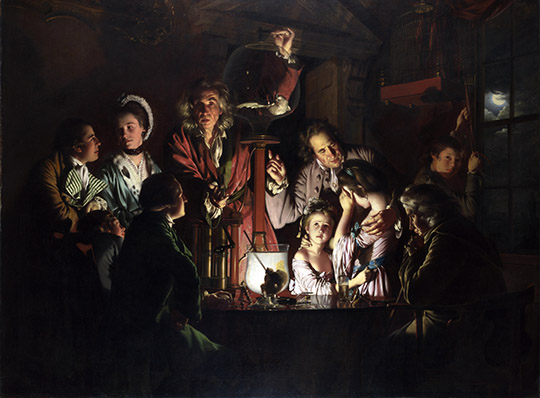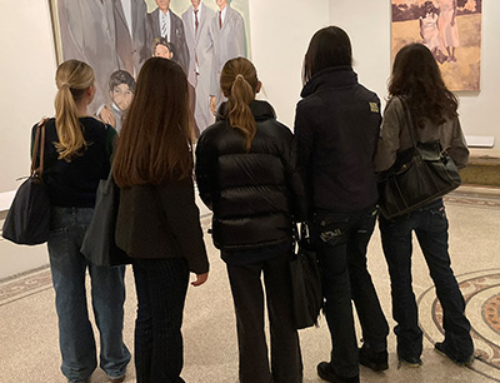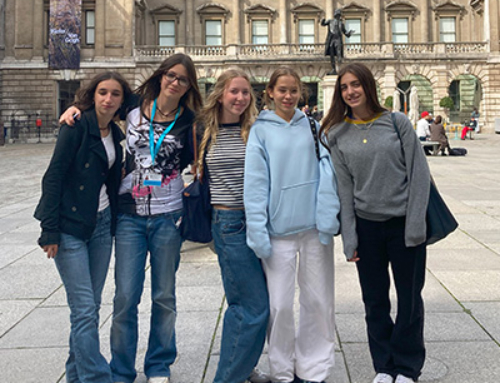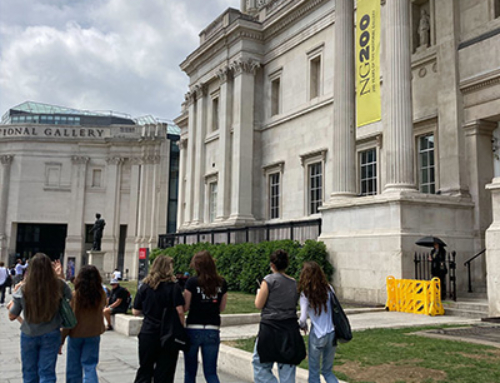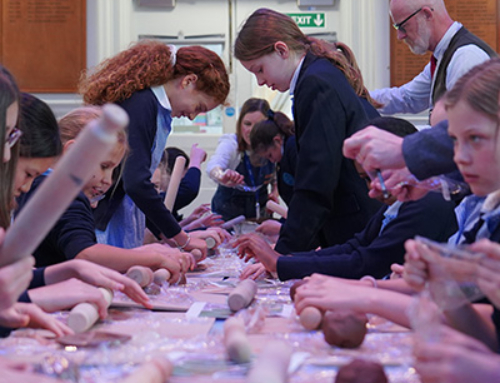This week, Ms Carr-Gomm discusses Joseph Wright of Derby’s ‘An Experiment on a Bird in an Air Pump’, 1768, oil on canvas, 183 x 244 cm, National Gallery London.
“A place has kindly been made for us to join a group of people gathered around a table on which a scientific experiment is taking place. In front of us a long, grey haired Professor Dumbledore type in a dark red gown looks straight out as if he is making the demonstration specially for us. He is controlling the flow of air in the glass bulb in which a poor bird demonstrates its near demise when a vacuum is created and it is temporarily deprived of oxygen.
In the eighteenth century lectures such as these were given in private houses as a form of entertainment for a family and their friends; you can see a handsome door frame behind the group. On the table, in the centre of the composition, is a vase holding a transparent milky liquid with what looks like a skull or an internal organ; a lung would make sense given that the lecture is about breathing and the straw may be there to show how it inflates. On the table to the right are two half globes which are also concerned with the effects of creating a vacuum. An old experiment found that when they were sealed together and the air taken out, 30 horses could not break them apart. The 18th century found the idea of nothingness difficult to grasp, especially as it could not be seen, but this new device clearly shows the result of a vacuum on a living being.
Joseph Wright of Derby shows us his great interest in the effects of light. A candle, which you can just make out on the left of the vase with the lung, casts its light dramatically on the group. On the right, a girl shields her eyes as she cannot bear to look and a father figure comforts her but, at the same time, encourages her to witness the spectacle. A child clasps onto the girls dress as she braves a glimpse at the fallen bird. To the left a young woman has absolutely no interest at all in what is going on and has eyes only for her loved one. The women act emotionally as 18th century women should while the men do and think.
To the right, though the window, a silvery and slightly sinister moon can be seen. This may refer to Wrights friendship with many members of The Lunar Society of Birmingham, a philosophical and intellectual club which included prominent men of the Enlightenment: Erasmus Darwin, botanist and grandfather of Charles Darwin; Josiah Wedgwood, potter and manufacturer; James Watt the steam engine pioneer; and Joseph Priestley, the discoverer of oxygen, to name a few. This club was a remarkable gathering of minds and in the exalted company of these Midland intellectuals Joseph Wright proudly adds of Derby to his name. It is thought that the lecturer, the man sitting on the right lost in thought and the stoic gentleman on the left, holding his watch to see how long the bird can survive, may all be portraits of some of the Lunar Societys members.
The lecturer has used the crank of the device to draw out the air from the glass bulb and his left hand is theatrically poised at the valve which, if opened, will restore the air and revive the bird. He is playing god but as the pretty bird is a rare cockatoo, it seems unlikely that he would wish to loose his expensive accessory; the boy to the far right seems poised and ready to lower the cage in which to return the bird when necessary. Perhaps the fragile thread between life and death is what the figure sitting on the right is contemplating. He is not looking at the experiment but at the candle; hes not even wearing his glasses. On the table, where the reflections show the considerable skill of the artist, we see a candle snuffer which can extinguish a flame in a second.
If you accepted the invitation to sit at this table, how would you react? Would you mind watching a bird being asphyxiated? Are you for or against animal testing? How far would you allow testing on animals to find a corona virus vaccine?”


